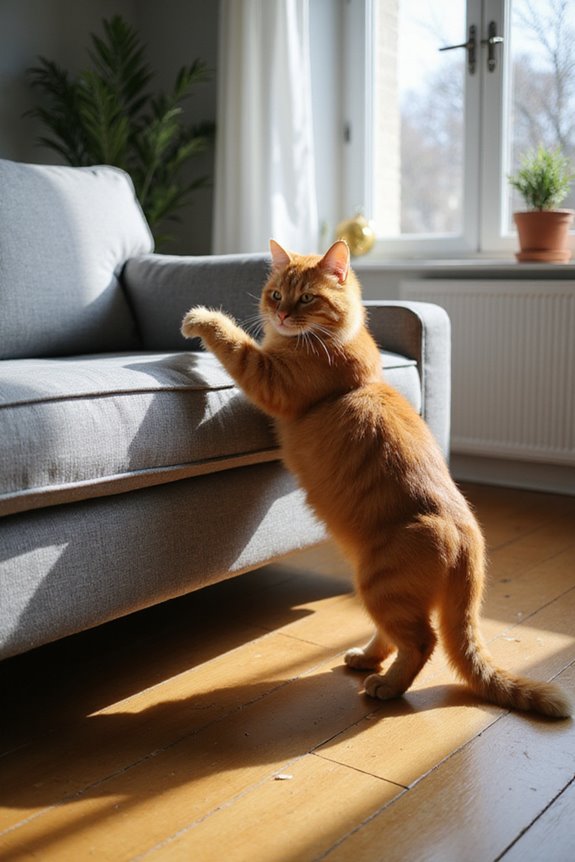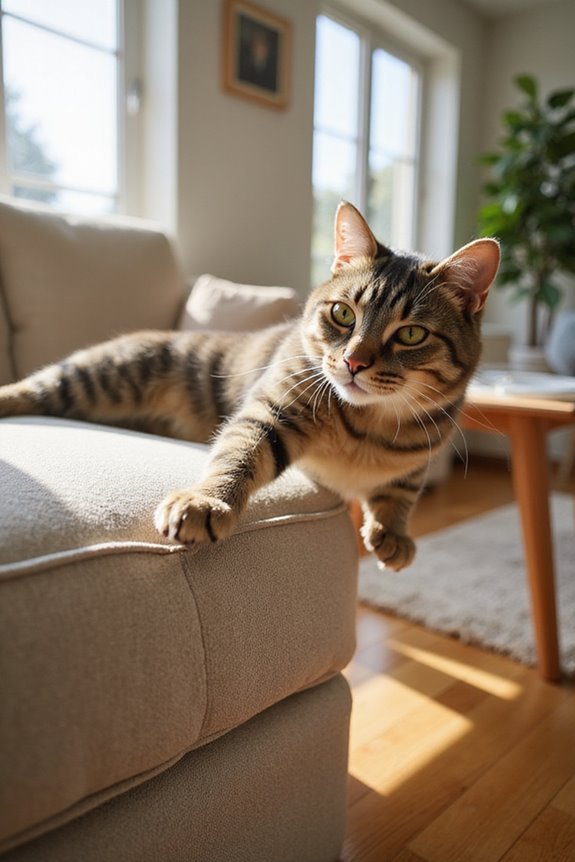Ever wonder why your cat scratches your furniture? Well, it’s in their nature! Scratching helps them mark territory, keep those claws sharp, and even relieve stress. You know how some people do yoga? Cats scratch for a similar reason! They’re stretching and maintaining their physical health. Plus, they can’t resist leaving their scent as a little “Welcome to my domain!” So, if you’re looking for ways to save your couch, stick around for some handy tips!
Key Takeaways
- Cats scratch furniture to mark territory with pheromones, fulfilling their instinctual need to communicate and assert presence.
- Scratching helps maintain claw health and provides necessary muscle stretching and tension relief, similar to a mini yoga session.
- Environmental factors, like noise and a lack of cozy spots, can increase a cat’s urge to scratch furniture out of stress or anxiety.
- Offering suitable scratching alternatives, such as scratching posts, can redirect scratching behavior away from furniture.
- Regular claw maintenance and protective measures, like couch guards, can help minimize furniture damage while satisfying a cat’s scratching needs.
Biological Reasons for Scratching

Have you ever wondered why your furry friend loves to scratch furniture? It’s not just to annoy you, I promise! Scratching serves important biological purposes, like scent marking. When your cat scratches, they release pheromones that let other cats know, “This is my turf!” Plus, it’s crucial for claw maintenance. Scratching helps shed old claw layers, keeping those claws sharp and healthy. Isn’t that fascinating?
But that’s not all! It’s also a great way for your cat to stretch their muscles and relieve tension. They’re instinctively fulfilling a natural behavior, like a mini yoga session! Interestingly, scratching is similar to how humans use decorative pillows to enhance comfort and relieve stress in their living spaces. So next time you catch them in the act, remember—it’s not just mischief; it’s essential cat business!
Environmental Influences on Scratching Behavior

It’s fascinating how your cat’s scratching habits can be influenced by their environment! For instance, if you have kids running around, your cat might scratch more due to the extra noise and sudden movements. These environmental stressors can create anxiety, making your fuzzy friend feel the need to scratch. Have you noticed this connection?
Additionally, household dynamics play a huge role. Changes, like new pets or furniture, can unsettle your cat. If they don’t have cozy nooks to hide or observe from, they might turn to your furniture for relief. Keeping their surroundings comfortable and providing plenty of scratching posts can help channel their energy positively. So, how can you set up your home to keep your cat happy and your furniture safe? One effective strategy is to consider space efficiency design, ensuring that your cat has dedicated areas for scratching and resting.
The Role of Survival Instincts

While you might think of scratching as just another quirky cat behavior, it actually ties deeply into their survival instincts. Did you know that this instinctual behavior stems from their wild ancestors? Scratching serves as one of their key survival tactics. It helps mark territory and provides a healthy outlet for stress. Ever see your cat scratching furniture? They’re effectively keeping their claws sharp and in working order!
Plus, scratching maintains their physical fitness, mimicking movements crucial for hunting. It’s like a natural gym session! Scalloped accent chairs can also provide a cozy spot for your pet to relax after their exercise. Isn’t it fascinating how these ancient behaviors persist even in modern homes? So, the next time your cat lunges at your couch, remember—it’s just following those deep-rooted instincts to thrive!
Communication Through Scratching

When you watch your cat scratching away at the couch or that fancy new scratching post, you might wonder if it’s just a way to vent their energy. But did you know that your furry friend is actually communicating? Cats release pheromones from their paw glands, marking their territory through scent communication. This invisible signal can alert other cats to their presence.
Scratching also creates visual signals, with those claw marks on surfaces showing who’s in charge! The height and location of these scratches can reveal confidence and emotional expression. So, when you see those marks, remember—it’s not just furniture destruction; it’s your cat’s way of asserting their territory and emotions! Isn’t that fascinating?
Specific Reasons for Scratching Furniture

Scratching furniture may seem like a mischievous habit, but there’s so much more going on beneath the surface! You might be surprised to learn that stress is one of the main scratching triggers for cats. Household changes—like new pets or even loud noises—could make your kitty anxious and lead to more furniture preferences that aren’t ideal!
Also, have you noticed your cat’s personality? Playful and high-energy cats tend to scratch more, as they’re expressing their natural claws’ maintenance needs! Plus, they leave their scent behind, marking their territory. Understanding these reasons can help you better manage their behavior. Want to reduce that scratching? Providing them with proper scratching materials could save your couch—and your sanity!
Preferred Scratching Surfaces of Cats
Cats love to scratch, but have you ever wondered why they have such strong preferences for different surfaces? Their scratching preferences often lean towards specific surface materials. For instance, sisal is a top pick because it’s durable and lets them dig in. Did you know many kitties enjoy corrugated cardboard, too? That rough texture really gets their claws going!
Some cats prefer scratching vertically, like on sisal ropes, while others might favor a cozy horizontal surface like carpet. Ever notice them going for wood? It’s sturdy and satisfying! By offering a mix of these surfaces, you can keep your feline friend happy and away from your furniture. Which surfaces do you think your cat likes best?
Scratching Behavior in Different Contexts
You might think you know your cat’s scratching habits, but there’s so much more at play! In multi-cat households, social dynamics can lead to increased scratching. Cats may scratch to establish territory, especially if they’re vying for your attention or their favorite sunny spot. Have you noticed more scratches as your kids run around? The presence of children can really stir things up, creating a playful and stimulating environment that gets your cat scratching more.
On the flip side, a lack of interaction can make your feline friend scratch out of boredom or anxiety. So, keep an eye on those social interactions! The more you understand your cat’s context, the better you’ll be at figuring out their scratching habits. Who knew feline behavior could be so fascinating?
Strategies for Managing Scratching Behavior
When it comes to managing your cat’s scratching behavior, understanding their needs can make all the difference! Have you noticed how certain textures seem to excite them? Consider scratching alternatives like sisal rope or sturdy carpet. Position scratching posts near their favorite lounging spots—they’ll be more likely to use them!
Do you have multiple cats? Setting up a few scratching posts can prevent competition. And don’t forget to enrich their environment! Provide toys and catnip to keep boredom at bay. Have you tried deterrents like vinyl guards? They can protect your furniture while redirecting your cat’s energy. Remember, a little training—and a lot of patience—goes a long way! Just think: a happy cat means happy furniture!
Health Benefits of Scratching
Scratching isn’t just a pesky habit; it’s actually packed with health benefits for your feline friend! You might not realize it, but when your cat scratches, they’re boosting their muscle flexibility. That stretching helps their back, legs, and paws stay agile and strong. Isn’t that awesome?
But it gets better! Scratching also provides stress relief. It releases endorphins, giving your kitty a little mood boost. Have you ever seen your cat scratch and then just happily flop down? That’s because they feel more relaxed!
Plus, scratching is a fantastic form of exercise. It keeps their claws healthy and sharp, ensuring your furry companion stays in tip-top shape. Who knew furniture scratching could be so beneficial?
Preventing Damage to Furniture
While you might find your cat’s scratching habits frustrating, there are plenty of ways to save your furniture from their claws! First off, investing in different scratching post options like sisal or cardboard can work wonders. Cats love variety, so try placing a few near their favorite lounging spots. Have you thought about using couch protectors or vinyl guards? These detours make your furniture less appealing for scratching!
What’s more, regular claw trimming can really help minimize damage. And if you’ve got multiple cats, having several scratching posts can keep the peace! Your furniture can survive, and your cats will still be happy. Who knew scratching prevention could be this fun and effective? Now, let’s save those sofas!
Frequently Asked Questions
How Can I Tell if My Cat Is Stressed From Scratching?
If you notice scratching signs, combined with other stress indicators like hiding or excessive grooming, your cat might be feeling stressed. Pay attention to frequency and locations to understand their emotional state better.
Do All Cats Scratch Furniture or Just Some?
When it comes to feline behavior, not all cats scratch furniture; some just can’t resist. Your cat’s scratching habits may vary widely, depending on personality, environment, and instincts, so don’t sweat it if yours doesn’t scratch.
Can Scratching Behavior Change With Age?
Yes, your cat’s scratching habits can change with age. You might notice age-related changes like reduced mobility or stress, impacting how frequently your feline friend uses scratching posts or engages in scratching behaviors.
Are There Specific Breeds That Scratch More Than Others?
When considering scratching tendencies, breed differences aren’t always clear-cut. Every cat’s individual personality plays a significant role, so rather than focusing solely on breed, observe your cat’s unique traits and habits to understand their scratching behavior.
Is It Possible to Train a Cat Not to Scratch at All?
Like teaching an old dog new tricks, training a cat to stop scratching isn’t foolproof. With patience, positive reinforcement, and alternative surfaces, you can guide them towards desirable behaviors while respecting their natural instincts.



